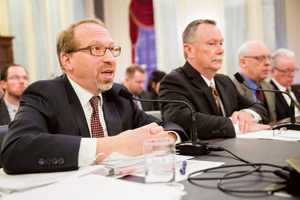Recruiting Drivers for Restart Study Proving Difficult, DOT Official Says

This story appears in the March 30 print edition of Transport Topics.
Federal regulators are having a hard time recruiting drivers to participate in a congressionally mandated study for the restart portion of the hours-of-service rule, a top U.S. Department of Transportation official told a Senate subcommittee.
“We do have a challenge, I should tell you, because the number of drivers that are actually likely to be subject to the restart requirements is a very small population that’s probably no more than 15% of the drivers that are out there,” said DOT Undersecretary of Transportation Policy Peter Rogoff, a witness before the surface transportation subcommittee.
Researchers will be challenged to find a sample that will allow an “adequate comparison” of those under the 34-hour restart and those not under the restart, Rogoff said.
The study contractor, the Virginia Tech Transportation Institute, he added, is working on recruiting the drivers with assistance from trucking companies around the country.
Congress suspended the restart rule until Sept. 30, pending the Federal Motor Carrier Safety Administration’s study of whether the rule bolsters highway safety. Under the suspended restart rule, drivers must take a rest break between 1 a.m. and 5 a.m. on two consecutive days.
Steven Mackay, a spokesman for the Virginia Tech Transportation Institute, said the goal is to recruit the drivers by March 31.
However, neither Mackay nor an FMCSA spokesman would comment on how many drivers have been recruited to date.
“We are confident that, with the appropriate level of assistance from industry, the study will be able to enlist the participation of enough drivers whose driving schedules require the use of the 34-hour restart provision,” FMCSA spokesman Duane DeBruyne told Transport Topics on March 25.
An 87-page outline of the study design made public earlier this month said that researchers hope to recruit 207 drivers from small, medium and large carriers.
The study calls for 117 dry-van drivers, 34 flatbed drivers, 34 refrigerated drivers and 22 tank drivers. They will each be paid up to $2,166 for participating in the minimum five-month operational field test.
Drivers’ habits behind the wheel will be closely monitored. They will be required to operate a truck equipped with a camera facing inward and a camera facing the road to monitor driving patterns, wear a wrist-activity monitor, maintain a sleep diary and caffeine log, track hours of service using an electronic logging device and perform smartphone-based assessments.
In addition, drivers will have to take pychomotor vigilance tests that measure the speed with which an individual responds to a visual stimulus.
Onboard technologies will capture such “safety-critical events” as hard braking, hard accelerations, swerves, contact with other objects and driving in excess of posted speed limits.
To be eligible, drivers will be required to hold a valid Class A commercial driver license, regularly drive and work close to the weekly hours-of-service requirements, complete most of the drives at night and regularly take a minimum one-night restart.
Rogoff said the DOT Inspector General has reviewed and approved the study design. He said the study will not be completed until the end of this year at the earliest, adding that it’s more important to “get it out right.”
Staff Reporter Michele Fuetsch contributed to this story.

